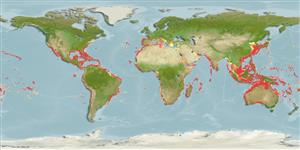Actinopterygii (ray-finned fishes) >
Perciformes (Perch-likes) >
Carangidae (Jacks and pompanos) > Caranginae
Etymology: Decapterus: Greek, deka = ten + Greek, pteron = wing, fin (Ref. 45335).
Environment / Climate / Range
Ecology
Marine; pelagic-oceanic; depth range 0 - 400 m (Ref. 58302), usually 40 - 200 m (Ref. 3197). Subtropical, preferred ?; 54°N - 46°S, 180°W - 180°E
Circumglobal. Western Atlantic: Nova Scotia, Canada and Bermuda to approximately Rio de Janeiro, Brazil (Ref. 57756). Appears to be absent from the Gulf of Mexico (Ref. 9626). Eastern Atlantic: St. Helena, Ascension, Cape Verde, and Gulf of Guinea (Ref. 7097); Azores and Madeira (Ref. 4233). Indian Ocean: Red Sea, Gulf of Aden, Seychelles, Mascarenes, South Africa, and Sri Lanka (Ref. 3287). Eastern Pacific: Gulf of California and Revillagigedo Island to Ecuador (Ref. 9283).
Size / Weight / Age
Maturity: Lm ? range ? - ? cm
Max length : 46.0 cm TL male/unsexed; (Ref. 55763); common length : 30.0 cm TL male/unsexed; (Ref. 55763)
Dorsal
spines
(total): 9;
Dorsal
soft rays
(total): 31-37;
Anal
spines: 3;
Anal
soft rays: 27 - 31. This species is characterized by the following: D VIII+I,31-36+1; A II+I,27-30+1; lateral line scales, curved 58-75 and without scutes, straight 14-29 with 24-40 scutes, total 110-137; gill rakers 10-13 + 34-38; rear end of upper jaw moderately rounded and slanted anteroventrally; no teeth on upper jaw; interorbital scales usually extending to above front margin of the pupil; color bluish green and slivery below; caudal fin yellow-green and dorsal fin lobe sometimes dark distally; with a small, black opercular spot (Ref. 3197, 11228).
Adults prefer clear oceanic waters, frequently around islands (Ref. 5217). Sometimes they are found near the surface, but generally caught between 40 and 200 m depth (Ref. 9283). Pelagic (Ref. 58302). Usually seen as fast moving schools along the reef edges near deep water (Ref. 48635, 26235). They feed mainly on zooplankton (Ref. 9283). Eggs are pelagic (Ref. 4233). Marketed fresh and salted or dried (Ref. 9283).
Life cycle and mating behavior
Maturity | Reproduction | Spawning | Eggs | Fecundity | Larvae
Smith-Vaniz, W.F., 1995. Carangidae. Jureles, pámpanos, cojinúas, zapateros, cocineros, casabes, macarelas, chicharros, jorobados, medregales, pez pilota. p. 940-986. In W. Fischer, F. Krupp, W. Schneider, C. Sommer, K.E. Carpenter and V. Niem (eds.) Guia FAO para Identification de Especies para lo Fines de la Pesca. Pacifico Centro-Oriental. 3 Vols. FAO, Rome. (Ref. 9283)
IUCN Red List Status (Ref. 115185)
CITES (Ref. 94142)
Not Evaluated
Threat to humans
Reports of ciguatera poisoning (Ref. 26235)
Human uses
Fisheries: commercial; gamefish: yes; bait: usually
Tools
Special reports
Download XML
Internet sources
